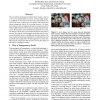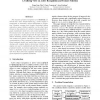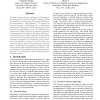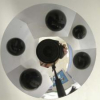101
click to vote
ICCV
2003
IEEE
15 years 6 months ago
2003
IEEE
Paracatadioptric sensors combine a parabolic shaped mirror and a camera inducing an orthographic projection. Such a configuration provides a wide field of view while keeping a s...
ICCV
2003
IEEE
15 years 6 months ago
2003
IEEE
The perception of transparent objects from images is known to be a very hard problem in vision. Given a single image, it is difficult to even detect the presence of transparent o...
ICCV
2003
IEEE
16 years 2 months ago
2003
IEEE
The algorithm presented in this paper aims to segment the foreground objects in video (e.g., people) given timevarying, textured backgrounds. Examples of time-varying backgrounds ...
115
click to vote
ICCV
2003
IEEE
16 years 2 months ago
2003
IEEE
The objective of active recognition is to iteratively collect the next "best" measurements (e.g., camera angles or viewpoints), to maximally reduce ambiguities in recogn...
70
Voted
ICCV
2003
IEEE
16 years 2 months ago
2003
IEEE
127
Voted
ICCV
2003
IEEE
16 years 2 months ago
2003
IEEE
This paper presents an algorithm for computing optical flow, shape, motion, lighting, and albedo from an image sequence of a rigidly-moving Lambertian object under distant illumin...
ICCV
2003
IEEE
16 years 2 months ago
2003
IEEE
We present a novel method for tracking objects by combining density matching with shape priors. Density matching is a tracking method which operates by maximizing the Bhattacharyy...
109
Voted
ICCV
2003
IEEE
16 years 2 months ago
2003
IEEE
We propose a principled account on multiclass spectral clustering. Given a discrete clustering formulation, we first solve a relaxed continuous optimization problem by eigendecomp...
108
click to vote
ICCV
2003
IEEE
16 years 2 months ago
2003
IEEE
Central catadioptric cameras are imaging devices that use mirrors to enhance the field of view while preserving a single effective viewpoint. In this paper, we propose a novel met...
ICCV
2003
IEEE
16 years 2 months ago
2003
IEEE
: Deformable 2D-3D medical image registration is an essential technique in Computer Integrated Surgery (CIS) to fuse 3D pre-operative data with 2D intra-operative data. Several fac...




